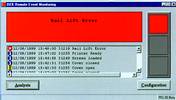
In this article, Dave Baker looks at how software can boost productivity in the latest manufacturing equipment.
The revolution that is packing cutting-edge technology into consumer products is enabled by the availability of volume- produced electronic components that can be combined with embedded software to build immense functionality into almost any product - the web-enabled refrigerator, for example. The same is also true of the production equipment that manufacturers are using to build these complex, densely populated and densely featured electronic devices. As the demands on manufacturing systems increase, in response to the increasing complexity and price sensitivity of electronic products, equipment designers are exploiting the power of digital software in order to satisfy user requirements.
Productivity features
Reducing operator intervention is seen as key to achieving the next level of productivity, and the route to this goal lies in raising the level of technology integrated into the manufacturing systems. Elements of modern manufacturing equipment under electronic and software control have taken a step beyond the basic motion and user interface features. While some of these advanced functions influence how the user interacts with the machine, others are less readily apparent. For example, signal processing techniques embedded in the alignment and inspection systems of SMT equipment have reduced the dependence of the machine on the quality of board finish in order to identify fiducials for board alignment. Although the user has no control over the settings of the alignment features, the benefit of improved pattern recognition software is manifested in the greater ability of the machine to align quickly, with improved acceptance of less expensive boards displaying less highly finished surface treatments.
Software products
The most exciting developments in machine automation are to be found in increasing levels of connectivity featured by successive new generations of equipment. Modern networking techniques are revolutionising practices in all sectors of business and electronic manufacturers are also able to benefit from this cultural change. DEK, for example, realised some time ago that enabling its printers to communicate using standard networking protocols would bring long-term benefits to its customers. By migrating the printers to the Windows NT Workstation operating system, this can be achieved using standard PC networking products which are readily available and competitively priced. Networking features native to the Windows 95/NT operating systems mean it is now easy for customers to integrate DEK printers into the corporate network.
However, this networkability is not to be confused with GEM-compliant links that enable host software such as line balancing and optimisation packages to be deployed for greater factory optimisation. Most SMT equipment features a GEM (SEMI E30) interface, and the equipment manufacturers and host software authors collaborate extensively, exchanging system design data to ensure a seamless interface between their products.

Networking
While host software developers concentrate on building enterprise-wide optimisation products, the machine vendors themselves are offering new tools that significantly enhance the user's ability to extract greater performance from their investment in capital equipment. The key enabler here is the ready availability of standard networking equipment which provides the foundation for equipment vendors to develop new ranges of productivity-enhancing tools. For growing manufacturing businesses, who may not have begun to invest in line-wide optimisation and programming software, these tools can represent a low-cost starting point in the drive toward greater optimisation, productivity and more flexible working.
Operator intervention
The ability to program a machine offline adds greatly to overall productivity by helping avoid machine downtime, thus minimising interruptions to manufacturing. Well designed offline editing tools enable complete machine programs to be generated, usually using a remote PC and also include good housekeeping features that enable programs to be easily stored and retrieved from a location on the corporate network.

Machine monitoring
But networking is enabling yet more powerful tools; if machine programs can be stored and manipulated away from the machine and then uploaded, there exist even better opportunities for interrogating the machine to gain exact information regarding utilisation and productivity. This is invaluable in assessing whether the machine is being used to its full capacity for a sufficient proportion of the time. A data standard, SEMI E10, has already been established to define the information types necessary to gain a full appraisal of machine utilisation. SEMI E10 data includes analysis of the machine productive state, equipment state and equipment reliability, as shown in Figure 1. The operating software of machines has featured the capability to log data that forms the basis of SEMI E10 data sets, but the tools to allow the user access to this data in a presentable form are just beginning to reach the market. By interrogating the event log of SMT equipment in the line, the user is able to pinpoint areas where productivity gains can be achieved. This ability to gain a comprehensive measure of machine performance, and to quickly create up to date reports for management purposes, enables manufacturing teams to determine courses of action and implement plans that will raise the productivity of equipment throughout the line.
By monitoring the event log in realtime, such tools can provide still greater control for production supervisors or engineers. DEK has recently introduced a remote event monitor (REM) that enables several machines to be supervised simultaneously from the desktop, with an alert beacon to indicate occurrence of a particular event specified by the user. Such an event could be a warning from any individual machine's visual inspection system, notification that the machine cover has been opened or any of a range of triggers. REM has proved to be a useful tool for rapidly solving production issues.
Integrating machines
The latest generations of in-line machines are allowing shopfloor staff and supervisors to control manufacturing resources by integrating them into the corporate network. Equipment based on an operating system such as Windows 95/NT now possesses all the connectivity properties of any desktop PC. This ability to exchange information with manufacturing systems across a standard network, such as 100 Mbps Ethernet, is set to change the way operators accomplish daily tasks and even how manufacturers organise their businesses.
| Tel: | +27 11 609 1244 |
| Email: | [email protected] |
| www: | www.zetech.co.za |
| Articles: | More information and articles about ZETECH ONE |

© Technews Publishing (Pty) Ltd | All Rights Reserved